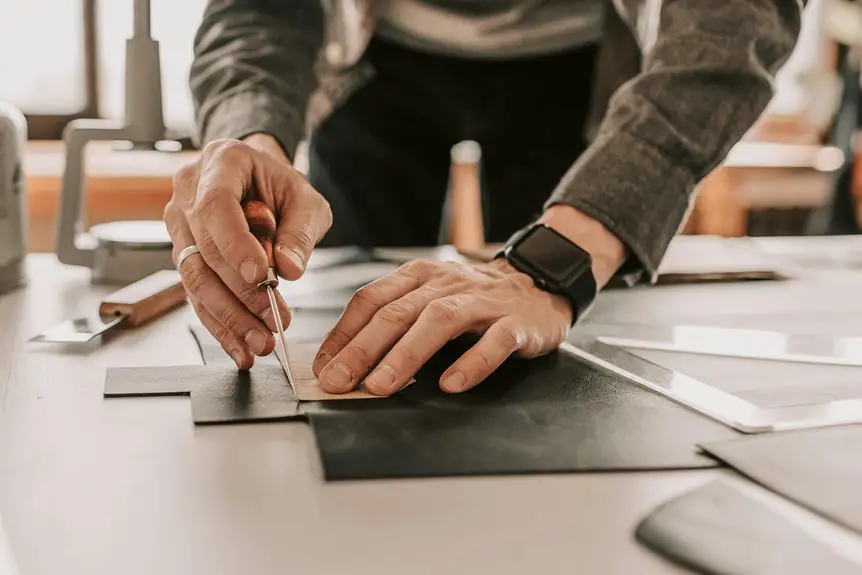Mushroom leather, or mycelium, is gaining attention as a sustainable alternative to traditional leather. You might wonder how this innovative material is made and what benefits it brings to the table. With its impressive strength and flexibility, mycelium leather could change the fashion landscape. But what does this mean for the industry’s future and our planet? Let’s explore the potential impact of this eco-friendly option.
Key Takeaways
- Mycelium leather is made from agricultural waste, transforming it into a versatile and eco-friendly material for various industries.
- It offers a lower carbon footprint and requires less water compared to traditional animal leather production.
- The material is biodegradable, breaking down naturally and contributing to a healthier environment.
- Mycelium leather’s impressive tensile strength and flexibility mimic animal leather, making it suitable for diverse applications.
- Ongoing innovations in bioengineering enhance its durability and aesthetics, positioning mycelium leather as a leading sustainable alternative.
The Mycelium Growth Process: From Waste to Wonder
While you might think of mushrooms only as a culinary delight, their mycelium offers an innovative solution for sustainable materials. This intricate network of fungal threads grows rapidly, converting organic waste into a strong, versatile substance.
By using agricultural byproducts, you help reduce landfill waste while nurturing mycelium’s growth. In just a few weeks, these threads can transform into a dense and durable material, ready for use in various applications.
The process isn’t only efficient but also low-energy, making it an attractive alternative to traditional leather production. As you explore the potential of mycelium, you’ll see how this remarkable growth process turns waste into wonder, paving the way for a more sustainable future in fashion and beyond.
Environmental Benefits of Mycelium Leather
Mycelium leather offers a range of environmental benefits that make it a game-changer in sustainable fashion.
By choosing mycelium over traditional materials, you’re contributing to a healthier planet. Here’s why it matters:
- Reduces waste: Mycelium utilizes agricultural byproducts, turning waste into valuable resources.
- Lower carbon footprint: It requires considerably less energy and water compared to animal leather production.
- Biodegradable: Unlike synthetic materials, mycelium leather breaks down naturally, reducing long-term waste.
- Supports biodiversity: Cultivating mycelium can enhance soil health and promote ecosystems.
Material Properties: Strength, Flexibility, and Adaptability
As you explore the material properties of mycelium leather, you’ll find that its strength, flexibility, and adaptability set it apart from traditional alternatives.
Mycelium leather boasts impressive tensile strength, making it durable enough for various applications, from fashion to furniture. You’ll appreciate its flexibility, which allows it to mimic the texture and feel of animal leather without sacrificing quality.
This material’s adaptability means it can be engineered to suit different needs, whether you require a sturdy product or a softer, more supple finish. Plus, its natural composition enables it to be customized with dyes and finishes, enhancing its aesthetic appeal.
Sustainability and Circular Economy in Mycelium Production
Given the growing awareness of environmental issues, the production of mycelium leather stands out as a beacon of sustainability.
This innovative material not only reduces waste but also contributes to a circular economy. By utilizing agricultural byproducts and mycelium’s natural growth, you’re embracing a model where resources are continuously repurposed.
Consider the benefits of mycelium leather:
- Reduces landfill waste by using agricultural leftovers.
- Biodegradable at the end of its life cycle, leaving no harmful residue.
- Requires less water compared to traditional leather production.
- Promotes local economies by sourcing materials regionally.
Choosing mycelium leather is a step towards a more sustainable future, allowing you to make eco-friendly choices without sacrificing quality or style.
Innovations and Future Trends in Mycelium Leather Development
While the domain of sustainable materials continues to evolve, innovations in mycelium leather development are pushing boundaries in both technology and design.
You’ll find that researchers are experimenting with various strains of fungi to enhance durability and texture, leading to products that mimic traditional leather even more closely.
New techniques, like bioengineering, are enabling the customization of mycelium properties, making it possible to create unique patterns and finishes.
As the market grows, collaborations between designers and biotech firms are expected to spur creativity and expand applications beyond fashion, like automotive and furniture industries.
With these advancements, mycelium leather isn’t just a trend; it’s a promising alternative that meets consumer demand for sustainability without sacrificing style.
Frequently Asked Questions
How Does Mycelium Leather Compare in Price to Traditional Leather?
Picture a new dawn in fashion. Mycelium leather usually costs less than traditional leather, but prices can vary based on production methods and demand. You’ll find that sustainability often comes with a price advantage.
What Are the Potential Applications for Mycelium Leather Beyond Fashion?
You can explore mycelium leather’s applications in furniture, automotive interiors, and packaging solutions. Its versatility makes it ideal for eco-friendly products, providing sustainable alternatives without compromising on quality or performance in various industries.
Is Mycelium Leather Waterproof or Water-Resistant?
You might be surprised to learn that mycelium leather isn’t exactly waterproof, but it’s impressively water-resistant! It can handle some moisture, yet prolonged exposure isn’t ideal. So, keep it dry to maintain its durability.
How Long Does Mycelium Leather Last Compared to Animal Leather?
Mycelium leather typically lasts around three to five years with proper care, while animal leather can last decades. However, it’s crucial to maintain both materials to guarantee their longevity and overall performance.
Can Mycelium Leather Be Dyed or Printed On?
Imagine a canvas waiting for color; yes, mycelium leather can be dyed or printed on. You’ll find vibrant possibilities, transforming it into unique pieces that express your style while embracing sustainability. Let creativity flourish!

